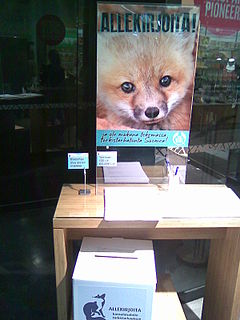The 1923 Alberta prohibition plebiscite, held on November 5, 1923, was a province-wide plebiscite held in Alberta, Canada, to allow alcoholic beverages, triggered by an affirmative vote in the Legislative Assembly of Alberta, based on the presentation of a 56,000-name petition in accordance with the requirements of the Citizens Referendum Law, initiative law, in force at the time. Prohibition was defeated by nearly 58 percent (58%) of the vote.

Alberta is a western province of Canada. With an estimated population of 4,067,175 as of 2016 census, it is Canada's fourth most populous province and the most populous of Canada's three prairie provinces. Its area is about 660,000 square kilometres (250,000 sq mi). Alberta and its neighbour Saskatchewan were districts of the Northwest Territories until they were established as provinces on September 1, 1905. The premier has been Rachel Notley since May 2015.

The Legislative Assembly of Alberta is one of two components of the Legislature of Alberta, the other being Elizabeth II, Queen of Canada, represented by the Lieutenant-Governor of Alberta. The Alberta legislature meets in the Alberta Legislature Building in the provincial capital, Edmonton. The Legislative Assembly consists of 87 members, elected first past the post from single-member electoral districts.

In political science, an initiative is a means by which a petition signed by a certain minimum number of registered voters can force a public vote in parliament called an indirect initiative or via a direct initiative, the latter then being dubbed a Popular initiated Referendum.
Contents
The previous policy of Prohibition was replaced by one of Moderation. Liquor would be sold in government stores, thus, the government took out the profit motive for "pushing" alcohol and would engage in little advertising to encourage sales. Consumers of liquor had to buy permits, which if mis-used could be "interdicted." As well, after the end of Prohibition, the government brought in the local option vote, whereby communities could hold votes to prohibit sales of liquor in their communities. Cardston for example has been dry since what for most others was the end of Prohibition. And to this day liquor cannot be purchased in Alberta grocery stores.
In economics, the profit motive is the motivation of firms that operate so as to maximize their profits. Mainstream microeconomic theory posits that the ultimate goal of a business is to make money. Stated differently, the reason for a business’s existence is to turn a profit. The profit motive is a key tenet of rational choice theory, or the theory that economic agents tend to pursue what is in their own best interests. Accordingly, businesses seek to benefit themselves and/or their shareholders by maximizing profits.

